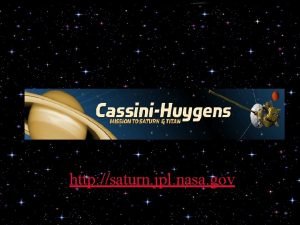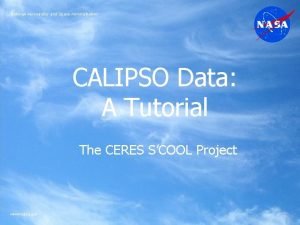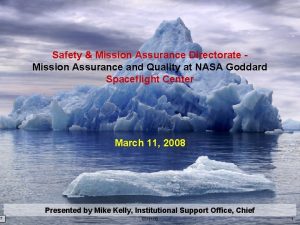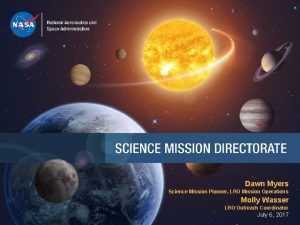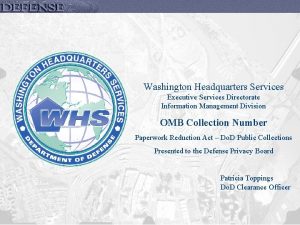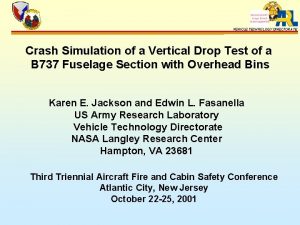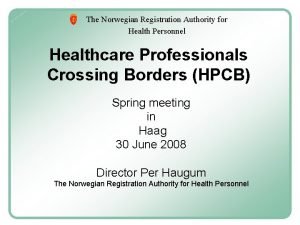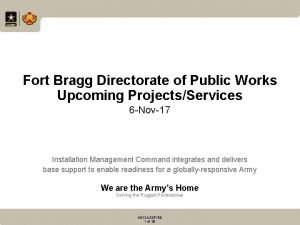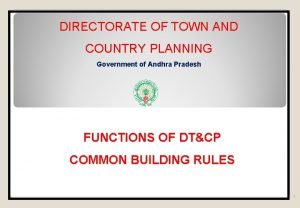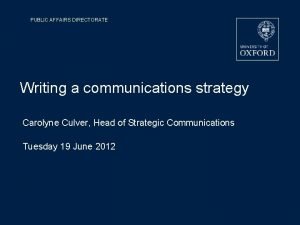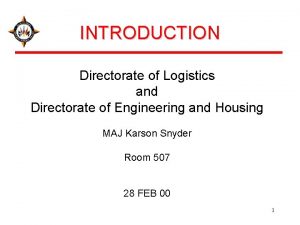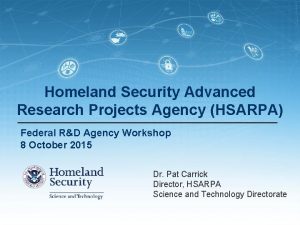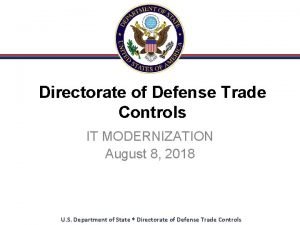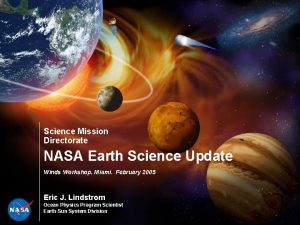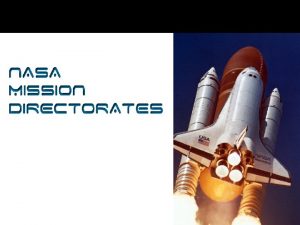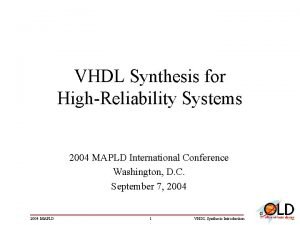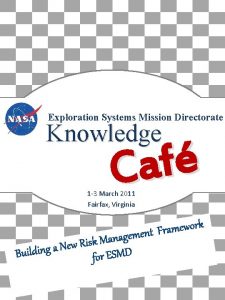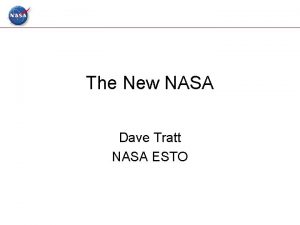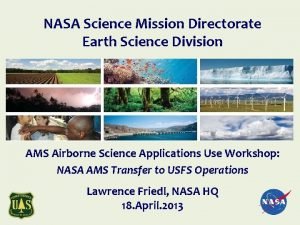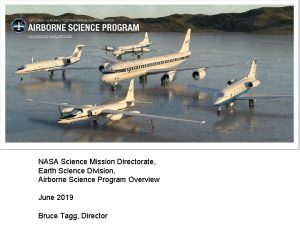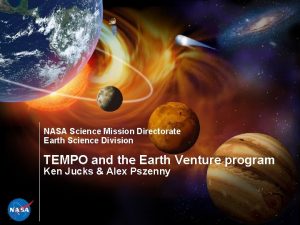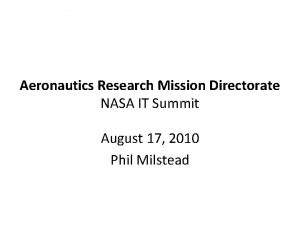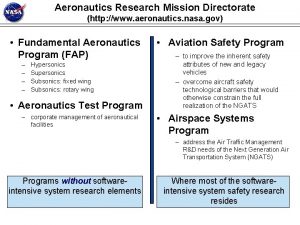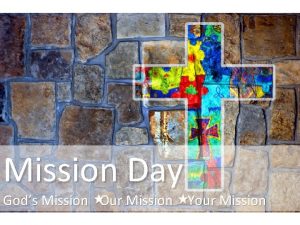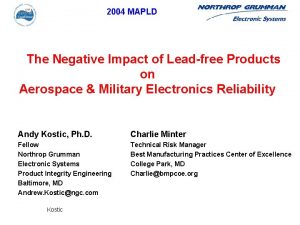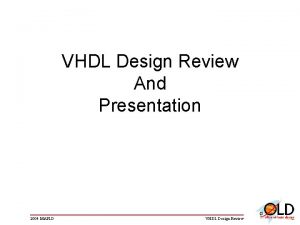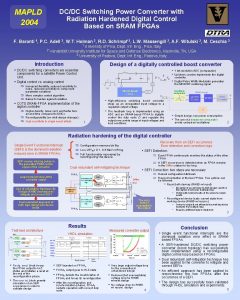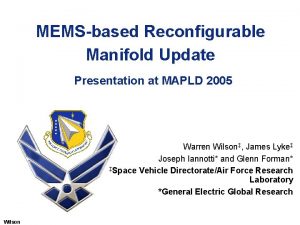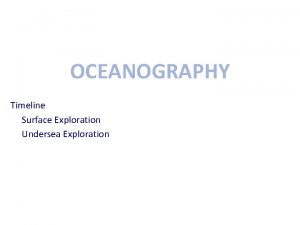Exploration Systems Mission Directorate NASA Update 2004 MAPLD



















- Slides: 19

Exploration Systems Mission Directorate NASA Update 2004 MAPLD International Conference Jim Nehman Deputy Associate Administrator Development Programs September 8, 2004

The Vision for Space Exploration THE FUNDAMENTAL GOAL OF THIS VISION IS TO ADVANCE U. S. SCIENTIFIC, SECURITY, AND ECONOMIC INTEREST THROUGH A ROBUST SPACE EXPLORATION PROGRAM Implement a sustained and affordable human and robotic program to explore the solar system and beyond Extend human presence across the solar system, starting with a human return to the Moon by the year 2020, in preparation for human exploration of Mars and other destinations; Develop the innovative technologies, knowledge, and infrastructures both to explore and to support decisions about the destinations for human exploration; and Promote international and commercial participation in exploration to further U. S. scientific, security, and economic interests. 2

Key Elements of the Vision • Objectives – Implement a sustained and affordable human and robotic program – Extend human presence across the solar system and beyond – Develop supporting innovative technologies, knowledge, and infrastructures – Promote international and commercial participation in exploration • Major Milestones – 2008: Initial flight test of CEV – 2008: Launch first lunar robotic orbiter – 2009 -2010: Robotic mission to lunar surface – 2011: First Unmanned CEV flight – 2014: First Crewed CEV flight – 2012 -2015: Jupiter Icy Moon Orbiter (JIMO) / Prometheus – 2015 -2020: First human mission to the Moon 3

The Vision in Detail 1. Return the Shuttle to safe flight as soon as practical, based on CAIB recommendations 2. Use Shuttle to complete ISS assembly 3. Retire the Shuttle after assembly complete (2010 target) 4. Focus ISS research to support exploration goals; understanding space environment and countermeasures 5. Meet foreign commitments 6. Undertake lunar exploration to support sustained human and robotic exploration of Mars and beyond 7. Series of robotic missions to Moon by 2008 to prepare for human exploration 8. Expedition to lunar surface as early as 2015 but no later than 2020 9. Use lunar activities to further science, and test approaches (including lunar resources) for exploration to Mars & beyond 10. Conduct robotic exploration of Mars to prepare for future expedition 11. Conduct robotic exploration across solar system to search for life, understand history of universe, search for resources 12. Conduct advanced telescope searches for habitable environments around other stars 13. Demonstrate power, propulsion, life support capabilities for long duration, more distant human and robotic missions 14. Conduct human expeditions to Mars after acquiring adequate knowledge and capability demonstrations 15. Develop a new Crew Exploration Vehicle; flight test before end of decade; human exploration capability by 2014 • Separate cargo from crew as soon as practical to support ISS; acquire crew transport to ISS after Shuttle retirement • Pursue international participation • Pursue commercial opportunity for transportation and other services

Presidential Commission Recommendations • Vision must be managed as National priority and shared commitment – By the President, Congress and the American people – Establish permanent Space Exploration Steering Council • NASA’s private sector relationship, organizational structure, business culture and management processes must be decisively transformed – Larger presence of private industry in space operations • • Preferred choice - but must be competitively awarded contracts NASA’s role must be irrefutable government only effort – Organization must be transformed into a leaner, more focused agency – Centers should be reconfigured as FFRDCs – Create 3 new organizations: technical advisory board; independent cost estimating group; research and technology organization – Adopt proven management reforms to implement the vision • • • “System-of-systems” approach Spiral, evolutionary development Reliance on lead system integrators Independent technical and cost assessments Other Recommendations – Pursue international partnerships – Seek input from scientific community on exploration architectures – Stimulate academic excellence in mathematics, science, and engineering 5

NASA TRANSFORMATION • President’s Commission on Space Exploration Policy – “NASA needs to transform itself into a leaner, more focused agency…” • Administrator O’Keefe Announced New Organization Structure – “…align Headquarters to eliminate ‘stove pipes’, promote synergy across the agency and support the long term exploration vision in a way that’s sustainable and affordable. ” • Transform Strategic Enterprises into Mission Directorates – Aeronautics Research: Conduct research and develop aeronautical technologies for safe, reliable and efficient aviation systems – Science: Carry out scientific exploration of Earth, Moon, Mars and beyond; chart the best route of discovery; and reap the benefits of Earth and space exploration for society – Space Operations: Direct space flight operations, space launches and space communications, as well as the operation of integrated systems in low-Earth orbit and beyond – Exploration Systems: Develop capabilities and supporting research and technology that enable sustained and affordable human and robotic exploration; includes the biological and physical research to ensure the health and safety of crew during long duration space flight 6

Exploration Systems Mission Directorate Associate Administrator (AA) for Exploration Systems C. Steidle Deputy AA Vacant Deputy AA Systems Integration Deputy AA Dev Programs/PEO D. Cooke Business Operations Division Director D. Mabey (Acting) J. Nehman Requirements Formulation Division Director M. Lembeck Research & Tech Development Deputy AA Research H. Ross Capability Development 7

Development Programs Deputy AA for Exploration Systems Development Programs / Program Executive Officer (PEO) Research & Technology Development Constellation Systems CEV Exploration Systems Research & Tech Human System Research & Tech Space Trans Systems Nehman’s Acq Bus to Hell Hubble Service Mission Nuclear Technology & Demonstration “Project Prometheus” Transition Programs 1 Supporting Surface Systems Supporting In-space Systems Advanced Systems & Technology Jupiter Icy Moons Orbiter Capability Development Research &Technology Development Note 1 Transition Programs: X-37, Orbital Express, , DART, PAD, NGLT, OSP 8

Constellation Program Acquisition Strategy Overview (Baseline) Pre-MS A Pre MS A Concept Ref (RFI) (BAA) Q 3 FY 04 Q 4 FY 04 OSP NGLT • ___ _ • ___ _ • _ MS A MS B Tech Dev’mt Program (RFP) Initiation Q 3 FY 05 FY 06 • ___ _ Design Readiness Review /Demo 2008 MS C Un-crewed CEV Flight 2011 2014 2015 (Objective) 2020 (Threshold) • ___ _ • _ Target Down Select System Development & Integration Early Contractor Involvement System Development & Demonstration Moon Mars Prometheus Tech Maturation 9

Cross-Agency, System of Systems Integration Transit and Launch Systems Crew Transport The Human: an Essential Element of the System of Systems Crew Support Comm/Nav Biomedical Countermeasures and Limits Long-Duration Habitation Supporting Research Surface Mobility Landing Systems Launch Resource Identification and Characterization Surface and Orbital Systems Pre-Positioned Propellants Surface Power and Resource Utilization Technology Options Mars Candidates Telescope Candidates Outer Moons Candidates Commonality/Evolvability For Future Missions 10

Project Constellation Acquisition Spirals Systems Engineering Vision • CEV Init Flt • 1 st Launch Lunar Robotic Orbiter 1 st Uncrewed CEV Flt 1 st Human Moon Mission 1 st Crewed CEV Flt Requirements Level 0, 1… Spiral 1 Concept Technology System Development and Demonstration. Production & Deployment Design Refinement System Development Readiness FRP Concept Integration OT&E Review Demonstration Decision Crewed Space Flight in LEO Operations & Support Decision Requirements Level 0, 1… Spiral 2 Program Initiation Concept Technology System Development and Demonstration. Production & Deployment Design Refinement System Development Readiness FRP Concept Integration OT&E Review Demonstration Decision Operations & Support Decision Tech Maturation for Spiral insertion Spiral Nth Spiral nth? Critical Milestones Moon: Ext. Duration (2015 -2020) Non-advocacy Reviews Independent Cost Reviews Mars (2020+) 11

Development Programs Status • Constellation Systems – Request for Information (RFI) released to industry, government, academia - completed – BAA for Concept Exploration & Refinement (CE&R) – selections completed • Preliminary concepts for human lunar exploration in 2015 -2020 • Initial CEV concepts – RFP for CEV Spiral 1 - release planned for Mar 2005 – Determination of “System Integrator” strategy under study by NRC • Project Prometheus (Nuclear Power and Propulsion Technologies) – Jupiter Icy Moons Orbiter (JIMO) program strategy realigned with Constellation systems – Nuclear power / propulsion Level I requirements completed, Linked to Constellation – RFP for follow-on JIMO development released – award expected in Sep 2004 • Competition between three prime contractors – continued competition being pursued – Secretary of Energy tasked Office of Naval Reactors (NR) to support Project Prometheus • Human & Robotic Technologies (H&RT) – Advanced Space Technology & Technology Maturation Programs • Intramural (NASA Centers) competition for technology projects completed • Industry BAA for H & RT System-of-System technologies – first down-select completed • Follow-on BAA for H & RT Gap-filling technologies planned for Jan 2005 – FY 2004 SBIR / STTR contract awards for phase 1 projects underway 12

Near-Term Acquisition Strategy FY 04 Q 3 Q 4 FY 05 Q 1 Q 2 FY 06 Q 3 Q 4 Q 1 Q 2 FY 07 Q 3 Q 4 Q 1 Q 2 Q 3 FY 08 Q 4 Q 1 Q 2 Q 3 Q 4 Government Requirements Development Iteration: 1 2 3 CEV Level 1 4 CEV Level 2 Industry Support RFI / Exploration Systems Center Tasks Release BAA / Project Constellation – Concept Exploration & Refinement Release Award Exercise Option CE&R BAA / Tech Maturation / ASTP Release Award Intramural BAA Call for Proposals System-of-Systems Technologies BAA Gap-filler Technologies RFP / CEV Spiral 1 Rel Draft CEV RFP Awd Final MS B - Program Initiation MS A SRR SDR PDR 2008 Demo Dev/Spiral 1 (2014 Manned Flight) Preliminary Design Contractor A 2008 Demo Dev/Spiral 1 (2014 Manned Flight) Preliminary Design Contractor B Detailed Design & Dev System of Systems Integrator - Acquisition Strategy in Work CEV Launch Vehicle - Acquisition Strategy in Work 13

International Involvement • Key Objective – Develop a sustained and affordable space exploration program utilizing international space agencies and industry participation to achieve breakthroughs in technologies and space exploration • Doing Business Differently – NASA International Coordination Team will define international strategy – Adopt lessons learned from a variety of international cooperation models – Identification and procurement of “best value” alternatives from international industry and government – Deviation to H&RT BAA to allow direct funding by NASA to foreign researchers • Working with Foreign Partners and Industry – Farnborough International, UK–July 2004 • Met with foreign partners and spoke to international industry – International Astronautical Congress, Vancouver, Canada-October 2004 • Follow-up meetings with partners to continue to gauge interest – NASA International Exploration Workshop, Washington, DC-November 2004 • Meet with a wide array of international space agencies to assess capabilities and next steps for cooperation 14

Office of Exploration Systems We’re not where we want to be, We’re not where we’re going to be, BUT we’re certainly not where we were yesterday.

Preparing for Mars Exploration • Moon as a test bed to reduce risk for future human Mars missions • Technology advancement reduces mission costs and supports expanded human exploration • Systems testing and technology test beds to develop reliability in harsh environments. • Expand mission and science surface operations experience and techniques • Human and machine collaboration: Machines serve as an extension of human explorers, together achieving more than either can do alone • Breaking the bonds of dependence on Earth: (e. g. /Life Science/Closed loop life support tests) • Power generation and propulsion development and testing • Common investments in hardware systems for Moon, Mars and other space objectives 16

The Human System: Types of Biomedical Risks Being Evaluated Effects of Radiation Medical Practice Problems • Carcinogenesis • Synergistic effects with microgravity or environmental factors • Late degenerative tissue effects • Trauma & acute medical problems • Illness & ambulatory health problems, renal stone formation • Toxic exposure Physiological Changes • Carcinogenesis due to immune system changes • Occurrence of serious cardiac dysrhythmia • Acceleration of age-related osteoporosis • Manifestation of previously asymptomatic cardiovascular disease • Toxic exposure Behavior and Performance Problems • Disorientation and inability to perform landing, egress, or other physical tasks, especially during/after G-level changes • Poor psychosocial adaptation • Sleep & circadian rhythm problems 17

Sustaining the Vision • How do you sustain the funding and support for the Vision during 30 budget cycles, 8 presidential elections, and many congresses? – Have a united front from Internal NASA, Industry, Academia, Researchers, Scientific and Engineering Communities – Develop clear and consistent messages – Engage broader communities – Deliver on commitments / responsible stewards of taxpayer $$ – Educate, inspire, and motivate the public 18

One Step at a Time • It is affordable and sustainable – Paced by experience, technology readiness and flexibility – Establishing Stepping Stones – Developing Building Blocks – technology to enable each successive steps – Employing New Approaches – spiral development – build and test – Fiscal Acquisition Management – Disciplined - • It is focused and achievable – Responds to the nation’s call for a long term space vision – We have an integrated agency approach – We have the talent, experience and leadership – recent successes and demonstrated management reforms – We have the passion and commitment to succeed 19
 Alternative of log based recovery
Alternative of log based recovery Apod nasa gov calendar 1982
Apod nasa gov calendar 1982 Awiting bayan halimbawa
Awiting bayan halimbawa Calipso browse images
Calipso browse images Safety and mission assurance
Safety and mission assurance Nasa mission planner
Nasa mission planner Executive services directorate
Executive services directorate Veterinary medicines directorate
Veterinary medicines directorate Vehicle technology directorate
Vehicle technology directorate Norwegian directorate of health registration
Norwegian directorate of health registration Nsw department of education
Nsw department of education Technical education karnataka
Technical education karnataka Dpw fort bragg
Dpw fort bragg Dtcp ap
Dtcp ap European directorate for the quality of medicines
European directorate for the quality of medicines Public affairs directorate oxford
Public affairs directorate oxford Directorate for logistics functions
Directorate for logistics functions Hsarpa
Hsarpa Deccs ddtc
Deccs ddtc Directorate general for competition
Directorate general for competition

